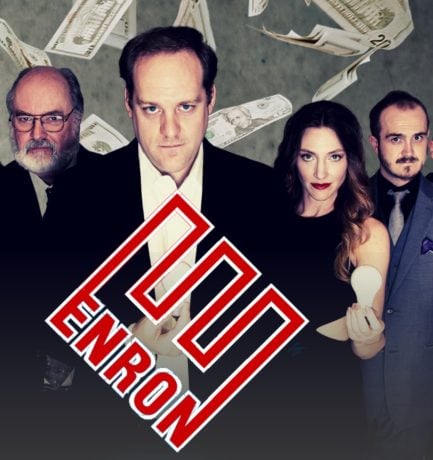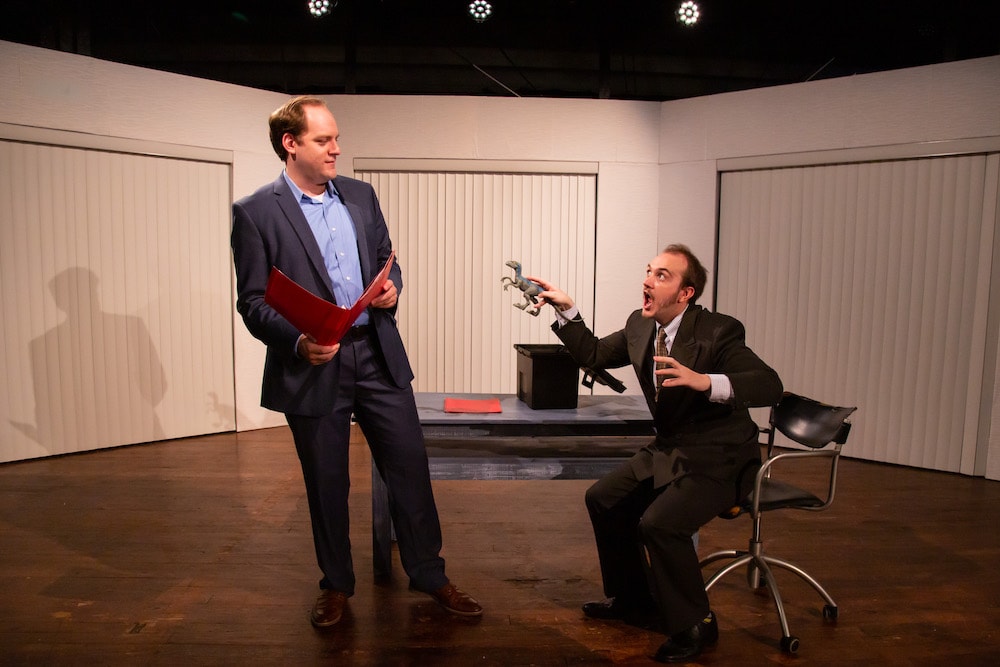Back in 1998, the official Enron vision and values statement had a line in it that said: “Ruthlessness, callousness, and arrogance don’t belong here.” Two years later, as the company’s stock skyrocketed based on shady accounting practices, that line was silently excised. No surprise. Among the rich white men in the upper echelons of Enron, ruthlessness, callousness, and arrogance had become so normalized it was company culture. By 2001, Enron went bust—the biggest scandal in U.S. capitalism to date—and tens of thousands lost jobs, medical coverage, and life savings. Meanwhile, the pale male poobahs pulled bonuses of millions.

If you think that true-life financial collapse sounds like the makings of a wonky documentary not terrific theater, you’ll think again after seeing 4615 Theatre Company’s rollicking and revealing production of Lucy Prebble’s 2009 play Enron. Prebble is British, and Enron was a huge hit in London. It flopped on Broadway, however. Some say it was because Americans weren’t ready for it. Some say the show was slain by Ben Brantley, who called it “a flashy and labored economics lesson.” Proving both mass think and Brantley dead wrong, the intrepid 4615 troupe has staged what looks today more like the most significant tragicomedy of our time.
In this post–Citizens United era when corporations get to be treated like peeps, it makes perfect sense to regard a corporation as a tragic hero, a character whose pride, just like in Sophoclean times, goeth before a horrific fall.
Hubris, thy name is Enron.
The capitalist character that is Enron is a composite of individually named co-conspirators whose combined flaws seal the vaunted hero’s fate. And here the 4615 production shines because Enron’s four main characters become the compelling human faces on a tragic arc of propulsive suspense.

Jeff Skilling (a driven Andrew Scott Zimmer) is the brains of the operation, the smartest guy in the room, the one who comes up with the big ideas that dupe investors and make billions. He’s not a bad guy. He’s a doting father. His views are Darwinian. He believes in his innocence to the end. He also in an early scene has a quickie in the boardroom with the woman who is his rival for the company presidency.
Her name is Claudia Roe (a cool Amanda Forstrom), an ambitious exec who plays hardball by boys’ rules—except she’s got a grasp on reality that Jeff doesn’t. There’s an electrifying scene between them when they clash over moneymaking ideas that are concrete and material, like actual power plants (Claudia’s position), or high-concept and virtual, like with energy traded as a chimerical commodity (Jeff’s brainstorm). Their boss Ken Lay the CEO sides with Jeff. Like, why pick a woman over a guy?
Ken Lay (a mild-mannered Nick Torres) founded the company and runs it like a beloved uncle who happens to be greedy AF. He’s a mediagenic proponent of Enron’s prospects, he woos and wins over market analysts who hype its stock, and he signs off on all Jeff’s moneymaking schemes—including the fatal one exploiting deregulated electricity that led to rolling power outages in California and ultimately Enron’s downfall.

The fourth main character is Andy Fastow (a nervous and nerdy Charlie Cook), who plays second financial fiddler to Jeff, cooking up shell companies with which to disguise the deep debt that Enron is really in. He so wants Jeff to appreciate him. He so wants to succeed. He so does not want to look bad when the shit hits the fan. He’s kind of the kingpin’s fool, on the fine line between tragic and pathetic.

As if Enron’s gripping Sophoclean storyline did not skewer corporate greed sufficiently, Prebble tosses in some Aristophanean farce for the make-fun of it. And here the ceaselessly theatrical imagination of Jordan Friend’s direction dazzles.
The real Andy Fastow called his phony firms raptors, and in Prebble’s fanciful rendering they appear literalized as voracious lizards who feed on debt. There’s a trio of them (Jon Jon Johnson, Ezra Tozian, Rachel Manteuffel) wearing cartoon dino heads (Benjamin Weigel did costumes), who circle the action like exotic pets with perilous personalities (Friend and Jonathan Ezra Rubin did movement choreography).
At points the stage fills with insane people-energy as traders in identical rep ties and suspenders shout into headsets, pound on tables, and frantically monitor the upturn/downturn market (Andrew Scott Zimmer did the multimedia design) to the tune of Pink Floyd’s “Money” (the witty sound design is Friend’s). There’s even some song and dance. A quartet sings a silly ode to Enron in four-part harmony.

Throughout, the play makes complicated financial concepts seem simple as Sesame Street. Ken Lay explains how GM invented bank financing so that those who couldn’t afford a Ford could have an auto their own (to the accompaniment of “Fanfare for the Common Man”). Andy Fastow explains what hedging means by animatedly acting out an airplane in flight and a rented car. And Jeff Skilling delivers a vivid image of inconceivable wealth when he explains that by counting out a dollar bill a second it would take him 32 years to reach one billion.
Interestingly, Claudia Row (who is Prebble’s invention, based on several Enron women) does not indulge in such edutainment. But she provides the best object lesson of all: She cashes in all her stock options just in time to get the hell out.

The supporting cast turns in a panoply of standout performances, some satiric (Joshua Simon as Enron’s see-no-swindle accounting firm, with a ventriloquist’s dummy; Jon Jon Johnson and Ezra Tozian as Enron’s blind-to-justice law firm), and several impressively serious (Michael Crowley as a straight-up security guard, Olivia Haller as a just-the-facts news anchor, Rachel Manteuffel as a clear-eyed stock analyst, Erik Harrison as an earnest lawyer, Sue Struve as a concerned congresswoman, Danielle Gallo as Skilling’s worried daughter).

The eye-filling, pulse-racing spectacle packs into a playing area with the audience on three sides almost seated in the action. The versatile set features an array of gray tables that get rearranged from scene to scene (including as the Enron trademark E) and an upstage wall has vertical louvered blinds that open and close three portals (scenic design is by Kathryn Kawecki; lighting design, by Jon Medley). The work world of a high-flying corporation is represented in spiffy business attire (costumes, Benjamin Weigel), and physical encounters happen impactfully (intimacy and fight direction, Jonathan Ezra Rubin).
The value of Lucy Prebble’s script is given its due with interest by 4615 Theatre Company. Enron plays as both a hilarious fable and a horrifying cautionary tale—a modern classic worthy of fear and pity, if not fury at the one percent.
As an investment of theatergoing time, Enron is an excellent buy.
Running Time: Two hours 30 minutes, including one intermission.
Enron plays through September 1, 2019, at 4615 Theatre Company performing at the Dance Loft on 14th, 4618 14th Street NW, Washington, DC, in repertory with Harold Pinter’s Betrayal. For tickets, go online.




